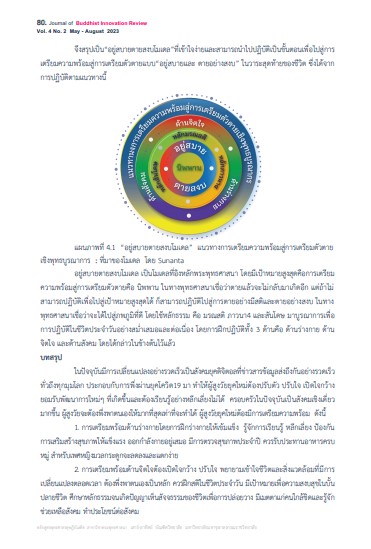การเตรียมความพร้อมของผู้สูงวัยยุคใหม่สู่การเตรียมตัวตายเชิงพุทธบูรณาการ
Main Article Content
บทคัดย่อ
ดุษฎีนิพนธ์ฉบับนี้มีวัตุประสงค์ ดังนี้ 1. เพื่อศึกษาแนวคิดทฤษฎีการเตรียมความพร้อมของผู้สูงวัยยุคใหม่ 2. เพื่อศึกษาหลักพุทธรรมที่นำมาบูรณาการในการเตรียมความพร้อมสู่การเตรียมตัวตายของผู้สูงวัยยุคใหม่ และ 3. เพื่อนำเสนอแนวทางการเตรียมความพร้อมของผู้สูงวัยยุคใหม่สู่การเตรียมตัวตายเชิงพุทธบูรณาการ งานวิจัยนี้เป็นงานวิจัยเชิงคุณภาพเครื่องมือที่ใช้ในการวิจัยได้แก่ แบบสัมภาษณ์เชิงลึก ผู้ให้ข้อมูลสำคัญ และวิเคราะห์ข้อมูลเชิงเนื้อหาโดยการนำเสนอข้อมูลในรูปแบบพรรณาวิเคราะห์
ผลการวิจัยพบว่า การเตรียมความพร้อมของผู้สูงวัยยุคใหม่ มี 3 ด้านคือด้านร่างกายต้องหมั่นออกกำลังกายอยู่เสมอ ตรวจสุขภาพประจำปี รับประทานอาหารที่เป็นประโยชน์ต่อร่างกาย ด้านจิตใจต้องเปิดใจกว้าง รู้จักปรับใจ มีจุดมุ่งหมายในชีวิต พึ่งพาตนเองเป็นหลัก และด้านสังคมมีกัลยาณมิตร เอื้อเฟื้อเผื่อแผ่ต่อผู้ใกล้ชิดและสังคม ส่วนหลักธรรมที่นำมาบูรณาการในการเตรียมความพร้อมสู่การเตรียมตัวตายได้แก่ มรณสติ ภาวนา4 และสันโดษ แนวทางการเตรียมความพร้อมของผู้สูงวัยยุคใหม่สู่การเตรียมตัวตายมี 3 ด้านคือด้านร่างกาย ดูแลสุขภาพด้วยตนเองและรักษาศีล5 อย่างเคร่งครัด ด้านจิตใจมุ่งปฏิบัติธรรมเพื่อให้ใจสงบและเกิดปัญญาโดยมีจุดมุ่งหมายเพื่อการตายอย่างสงบหรืออาจไปสู่นิพพาน และด้านสังคม โดยอยู่อย่างสันโดษและปล่อยว่าง มีกัลยาณมิตร เตรียมจัดงานศพตนเอง จัดการทรัพย์สิน พินัยกรรม พินัยกรรมชีวิตให้เรียบร้อยเพื่อไม่ต้องค้างคาใจตอนใกล้ตาย
องค์ความรู้ที่ได้จากการวิจัยได้จัดเป็นโมเดล “อยู่สบายตายสงบ” โดยมีเป้าหมายในการเตรียมความพร้อมสู่การเตรียมตัวตายคือการตายอย่างสงบ หรืออาจไปสู่เป้าหมายสูงสุดคือนิพพาน การตายอย่างสงบทางพุทธศาสนาเชื่อว่าจะไปเกิดในภพภูมิที่ดี โดยใช้หลักธรรม มรณสติ ภาวนา4 และสันโดษ มาบูรณาการเพื่อการฝึกปฏิบัติทั้ง 3 ด้านคือ ด้านร่างกายโดยการรักษาศีล5 ด้านจิตใจและปัญญาโดยฝึกสติในชีวิตประจำวันและฝึกมรณสติอยู่เสมอๆจนเกิดปัญญาทั้งทางโลกและทางธรรม และด้านสังคมอยู่อย่างสันโดษและรู้จักปล่อยวาง
Article Details

อนุญาตภายใต้เงื่อนไข Creative Commons Attribution-NonCommercial-NoDerivatives 4.0 International License.
เรื่องลิขสิทธิ์/เป็นความคิดเห็นของผู้เขียน
เอกสารอ้างอิง
หนังสือ
กรมกิจการผู้สูงอายุ (2562). เติมรู้เตรียมพร้อมก่อนสูงวัย. กรุงงเทพมหานคร: จัดพิมพ์โดยกองส่งเสริมศักยภาพผู้สูงอายุ.
พระธรรมธีรราชมหามุนี (โชดก าณสิทฺธิ). (2532). มงคล 38. กรุงเทพมหานคร: หจกการพิมพ์พระนคร.
พระธรรมปิฏก (ป.อ. ปยุตฺโต). (2544). พุทธธรรม (ฉบับเดิม). พิมพ์ครั้งที่ 11. กรุงเทพมหานคร: ดวงแก้ว.
มหาวิทยาลัยมหาจุฬาลงกรณราชวิทยาลัย. (2539). พระไตรปิฎก ภาษาไทยฉบับมหาจุฬาลงกรณราชวิทยาลัย.
กรุงเทพมหานคร: โรงพิมพ์มหาจุฬาลงกรณราชวิทยาลัย.
พุทธทาสภิกขุ. (2549). ตายก่อนตายดับไม่มีเหลือ. กรุงเทพมหานคร: บ้านลานธรรม.
สำนักส่งเสริมสุขภาพ กรมอนามัยกระทรวงสาธารณสุข. (2548).การส่งเสริมสุขภาพผู้สูงอายุ.กรุงเทพมหานคร:กระทรวงสาธารณสุข.
สุวัฒน์ มหัตนิรันดร์กุล และคณะ. (2540). เปรียบเทียบแบบวัดคุณภาพชีวิตขององค์การอนามัยโลกทุก 100 ตัวชี้วัดและ 26 ตัวชี้วัด. โรงพยาบาลสวนปรุง: จังหวัดเชียงใหม่.
วารสาร
พระครูอรรถจริยานุวัตร (สุเทพ ศรีทอง). (มกราคม-ธันวาคม 2564).การเตรียมตัวตายตามแนวพระพุทธศาสนา. วาสารวิชาการโรงเรียนนายเรือด้านสังคมศาสตร์ มนุษย์ศาสตร์และศึกษาศาสตร์; 8 (1): 6
สัมภาษณ์
พระอาจารย์ไพศาล วิสาโล เจ้าอาวาสวัดป่าสุคะโต อำเภอแก้งคร้อ จังหวัดชัยภูมิ, วันที่สัมภาษณ์ 10 มีนาคม 2566.
พระเมธีวรญาณ ผศ.ดร.. คณบดีคณะพุทธศาสตร์ มหาวิทยาลัยมหาจุฬาลงกรณราชวิทยาลัย, วันที่สัมภาษณ์ 17 มีนาคม 2566.


